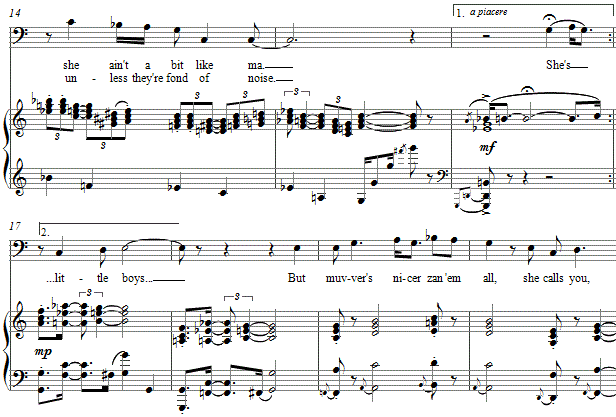Music and Texts of GARY BACHLUND
Vocal Music | Piano | Organ | Chamber Music | Orchestral | Articles and Commentary | Poems and Stories | Miscellany | FAQs
Appreciation - (2010)
Paul Laurence Dunbar
for baritone and piano
My muvver’s ist the nicest one
‘At ever lived wiz folks;
She lets you have ze mostes’ fun,
An’ laffs at all your jokes.
I got a ol’ maid auntie, too,
The worst you ever saw;
Her eyes ist bore you through and through,—
She ain’t a bit like ma.
She’s ist as slim as slim can be,
An’ when you want to slide
Down on ze balusters, w’y she
Says ‘at she’s harrified.
She ain’t as nice as Uncle Ben,
What says ‘at little boys
Won’t ever grow up to be big men
Unless they’re fond of noise.
But muvver’s nicer zan ‘em all,
She calls you, “precious lamb,”
An’ let’s you roll your ten-pin ball,
An’ spreads your bread wiz jam.
An’ when you’re bad, she ist looks sad,
You fink she’s goin’ to cry;
An’ when she don’t you’re awful glad,
An’ den you’re good, Oh my!
At night, she takes ze softest hand,
An’ lays it on your head,
An’ says “Be off to Sleepy-Land
By way o’ trundle-bed.”
So when you fink what muvver knows
An’ aunts an’ uncle tan’t,
It skeers a feller; ist suppose
His muvver ‘d been a aunt.[ 4 pages, circa 3' 00" ]
Paul Laurence Dunbar
From Dunbar's collection, Lyrics of Sunshine and Shadow (1901), comes another of his delightful dialect poems. As I have become more familiar with his and other poet's various attempts to capture dialect in writing, I find the vagaries of spelling most interesting. In this, "ist" is an contraction of sorts for "just," as one example. Not all dialect for any given group is identical, nor codified. To my reading and after becoming more familiar with Gullah, another American dialect, I notice significant differences and so urge the singer to take care with the pronunciation so as to honor Dunbar's attempt at capturing this kind of speech.
Written for baritone as the text is specifically "boyish" in its perspective, I mused a while about parallel movement among major triads, and then opposite movement with varying intervals. For this pre-compositional thinking, a "map" suggested certain chord relationships and spellings. In this particular example, the bass line's triads are broken into open form arpeggio moving by diatonic thirds, while the upper voice triads are closed form and moving in half steps in opposite motion. I might be represented thus, the second set being the transposition of the first by a third.
Then, the gesture for the accompaniment becomes measures 2-5 on C and then 6 and beyond on E. The vocal line above insinuates itself into a general C major-minor above, but accommodates to the various chord changes. For this the accompaniment is stuffed with major triads in parallel motion in a polytonal palette still implying a tonality.
A "riff" separates stanza as the parallel triads in the upper voices shift into triplets for a moment, breaking the previous gestural and harmonic rhythms. At the bridge in this song form, the map disappears in favor of another set of parallel gestures of five note diatonic chords.
The coda reprises the triplet "riff," the chord forms from the bridge and gesture from the introduction to round out this song setting.
The score for Appreciation is available as a free PDF download, though any major commercial performance or recording of the work is prohibited without prior arrangement with the composer. Click on the graphic below for this piano-vocal score.
S



